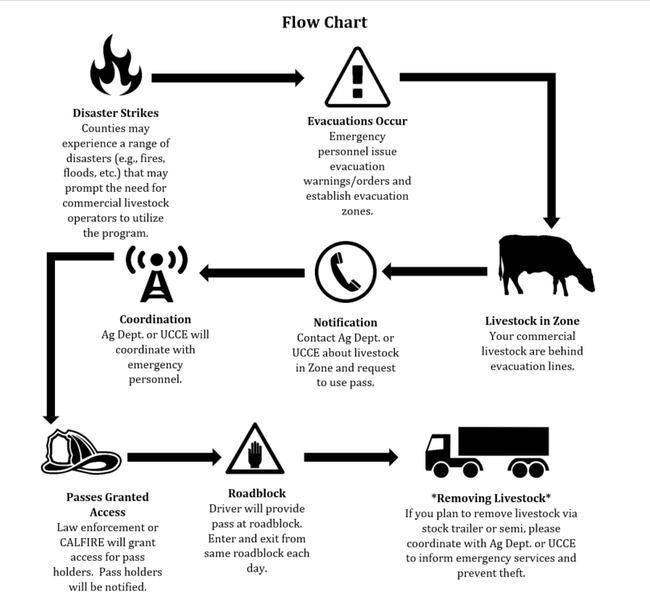With the month of May upon us, wildfire season (at least here in the Sierra foothills) is just around the corner. Indeed, May is Wildfire Awareness Month - the National Interagency Fire Center website is a great source of information on steps we can all be taking to make our communities, ranches, and homes more fire safe and fire resilient.
If you operate a ranch in Nevada, Placer, or Yuba County, one of the first steps you should consider taking is registering for this year's Disaster Livestock Access Program. Developed last year by a steering committee comprised of local ranchers, agricultural commissioners, and UC Cooperative Extension, the Disaster Livestock Access Program is designed to coordinate with emergency managers to provide ranchers with access to livestock in evacuation zones for the purpose of feeding, watering, and caring for commercial livestock.
Our program is unique in that our geographic coordination mirrors that of our local CALFIRE unit (which reflects the on-the-ground reality that many commercial ranches operate in multiple counties). Each county will recognize a pass issued by any of these three counties (Nevada, Placer, and Yuba).
Who qualifies for a Disaster Livestock Access Pass?
For the purposes of this program, a commercial livestock operator is defined as owning or managing 50+ head of livestock (including in utero, e.g., 25 bred cows), 100+ poultry or rabbits, or 50+ beehives that reside in Placer, Nevada, or Yuba County for at least a portion of the year. Cattle, sheep, goats, hogs, poultry, rabbits, llamas, alpacas, and bees that are "commercially raised" (e.g., as part of a business) qualify for the program. The program applies to both private land (owned or leased) as well as to public land (including US Forest Service and BLM grazing allotments).
Will a Disaster Livestock Access Pass get me through a road block?
Not necessarily. Your local agricultural department and I will work with incident command to identify areas within evacuation zones that are safe for passholders to access. Refer to the incident flowchart below for more details.
How do I get a Disaster Livestock Access Pass?
To enroll in the program, you must provide contact information, APNs, physical addresses, and/or allotment names of grazing sites, general season(s) of use, livestock description and inventory, and release of liability. You can register online at the N-P-Y Disaster Livestock Access Registration Site or by contacting me directly at dmacon@ucanr.edu or (530) 889-7385. Ranchers will need to apply each year; even if you received a pass in 2021, you'll need to complete this registration process again this year.
Is training required?
If you haven't held a pass previously, you'll need to participate in a 4-hour training session on Saturday, June 4, 2022, from 9am to 1pm at the UC Sierra Foothill Research and Extension Center in Browns Valley, CA. This training will provide an overview of the program, information on the incident command system and wildfire behavior, and an opportunity to ask questions with local law enforcement, emergency services, and CALFIRE. If you held a pass last year, you'll need to participate in a 1-hour virtual refresher course currently in development.
Preparation is Key!
Three days before our first 2021 training session, the River Fire tore through parts of Placer and Nevada Counties. Several of the ranchers who came to the workshop were able to describe the chaos and confusion of the early hours of the fire - as well as the need to coordinate with law enforcement and fire officials on the fly. Hopefully this program will improve our ability to communicate during an emergency - and provide access to care for livestock.
If you have questions, please contact me at dmacon@ucanr.edu or (530) 889-7385.
